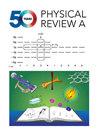Temperature dependence of optical phase transitions in a system of two-level atoms and photons interacting inside a nonlinear cavity
IF 2.9
2区 物理与天体物理
Q2 Physics and Astronomy
引用次数: 0
Abstract
In the present work, the role of temperature in the occurrence of optical phases in a system of a large number of atoms interacting with photons is reported. To this end, it is assumed that the cavity inside which the constituents interact is in equilibrium with a heat reservoir, held at a fixed temperature. To achieve this goal, we start with the conventional density operator to calculate the mean values of electromagnetic quadratures. To make the realization of three distinct optical phases, trivial, electric, and magnetic superradiance, possible, the medium inside the cavity is assumed to be a second-order nonlinear one. The nonlinearity of the medium is further assumed to be activated by an externally applied classical pump field. As a consequence, now there are two external controlling agents, the temperature and nonlinearity strength. We then proceed to calculate the quadrature mean values in the thermodynamical limit and for a large number of atoms as a function of temperature. An analysis of the calculated mean values, along with relevant figures, reveals temperature-dependent conditions for realizing trivial, electric, and magnetic optical phases. Moreover, we shall demonstrate that the atom-field coupling strength gives rise to two distinct regimes where the optical phases behave quite differently. In one of the two regimes it is possible for the phases to coexist, while in the other it is not. As a profound result, it is demonstrated that for such a system there can exist a unique temperature (triple point) at which the three optical phases coexist.

在非线性腔内相互作用的两级原子和光子系统中光学相变的温度依赖性
本研究报告探讨了温度在大量原子与光子相互作用的系统中产生光学相位的作用。为此,我们假定原子相互作用的空腔与一个保持固定温度的热库处于平衡状态。为了实现这一目标,我们从传统的密度算子开始计算电磁四次方的平均值。为了能够实现三种不同的光学相位,即微分、电和磁超辐射,我们假设空腔内的介质为二阶非线性介质。介质的非线性被进一步假定为由外部施加的经典泵浦场激活。因此,现在有两个外部控制因素:温度和非线性强度。然后,我们继续计算热力学极限下的正交平均值,以及大量原子的正交平均值与温度的函数关系。对计算出的平均值以及相关数字的分析,揭示了实现三相、电相和磁光相的温度相关条件。此外,我们还将证明,原子-场耦合强度会导致两种截然不同的状态,在这两种状态中,光学相的表现截然不同。在其中一种情况下,光学相可以共存,而在另一种情况下,光学相则不能共存。一个深刻的结果是,对于这样一个系统,可以存在一个独特的温度(三重点),在这个温度下,三个光学相位可以共存。
本文章由计算机程序翻译,如有差异,请以英文原文为准。
求助全文
约1分钟内获得全文
求助全文
来源期刊

Physical Review A
物理-光学
CiteScore
5.40
自引率
24.10%
发文量
0
审稿时长
2.2 months
期刊介绍:
Physical Review A (PRA) publishes important developments in the rapidly evolving areas of atomic, molecular, and optical (AMO) physics, quantum information, and related fundamental concepts.
PRA covers atomic, molecular, and optical physics, foundations of quantum mechanics, and quantum information, including:
-Fundamental concepts
-Quantum information
-Atomic and molecular structure and dynamics; high-precision measurement
-Atomic and molecular collisions and interactions
-Atomic and molecular processes in external fields, including interactions with strong fields and short pulses
-Matter waves and collective properties of cold atoms and molecules
-Quantum optics, physics of lasers, nonlinear optics, and classical optics
 求助内容:
求助内容: 应助结果提醒方式:
应助结果提醒方式:


